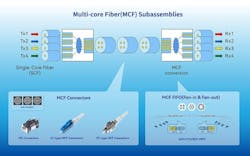HYC to Unveil Multi-Core Fiber (MCF) Subassemblies at ECOC 2024
As applications like 5G, AIGC, and cloud computing continue to evolve, the demand for fiber transmission capacity is rapidly increasing. However, traditional single-mode fiber is reaching its limitation due to the Nonlinear Shannon Limit (the maximum theoretical capacity of an optical cable), which restricts the growth of optical network capacity. Spatial Division Multiplexing (SDM) technology using multi-core fiber (MCF) is expected to be the optimal solution to break through this limitation. Multi-core fiber refers to an optical fiber that contains multiple cores within a single strand of optical fiber. For example, 4-core MCF integrates "four cores" within a fiber with a diameter of only 125μm, significantly increasing transmission capacity while reducing per-bit cost.
Based on its capabilities in free-space optics design and mature precision coupling, HYC has developed Multi-core Fiber-based series subassemblies:
- 4CH/7CH/8CH MCF optical fiber connectors
- MCF FIFO (Fan-in & Fan-out)
- MCF Hybrid subassemblies used in EDFA
How to connect multi-core optical fibers? The common fiber connectors in the industry are primarily designed for traditional single-core fibers, and MCFs are often connected by fusion splicing. The difficulty of on-site fusion splicing is that the core spacing between multi-core optical fibers is different, making it difficult to couple accurately. In order to solve this problem, HYC has developed LC-type/FC-type optical fiber connectors specifically for MCF connections. It is modified and redesigned based on the traditional LC/FC connector, optimized the positioning and maintaining functions, and improved the grinding and coupling process to ensure that the small insertion loss variation after many times couplings.
Another challenge in MCF applications is connecting multi-core fibers with conventional single-core fibers. To achieve practical use of MCF, spatial multiplexers/demultiplexers known as fan-in/fan-out (FIFO) devices that efficiently couple light from single-core fiber (SCF) into each multi-core fiber (MCF) or the opposite direction. HYC's MCF FIFO has good performance with a 43μm core pitch offer low average coupling loss (<0.5dB), low crosstalk (>45dB), and high return loss (>55dB).
In addition to 3D waveguide technology, HYC is also developing 3D waveguide technology to realize FIFO devices. Femtosecond laser is directly written on platforms such as glass, polymers, planar optical waveguides, and silicon-based or silicon nitride, transmitting light from MCF to single-core fibers through different waveguides. The key process is the writing of 3D waveguide chips. Once solved, it will be easy to realize mass production of FIFO devices.
To achieve high-capacity, high-speed, and long-distance transmission in spatial division multiplexing (SDM) systems, optical amplifiers are crucial for compensating transmission losses. SDM fiber amplifiers are crucial for the practical application of SDM technology, and multi-core erbium-doped fiber amplifiers (MC-EDFA) are key components of SDM transmission systems. HYC offers collaborative development of EDFA systems for multi-core fibers (MCF), providing ODM/JDM services during the customer’s design-in phase. The customized subassemblies include MCF Isolator + TAP; MCF 980/1550 WDM; MCF GFF, etc.
Multi-core fibers (MCF) are widely used in SDM systems, data center interconnects, chip-to-chip communication, next-generation optical amplifiers, quantum communication technologies, and more. Based on seven core technology platforms, HYC is set to introduce MCF subassemblies with larger cores, such as 7-core, 8-core, and 19-core.
For more technical details and product information, we invite you to visit HYC’s booth (#D65) at the ECOC2024 in Frankfurt from September 23-25.
